|
Thanks to the superb canvassing of detective Ken Clark and his SSD team, we can put in place a fairly reliable prowling sequence engaged in by EAR-ONS in the months and even weeks preceding the Maggiore Double Murder. This is a vital resource that extends beyond its application to the murder of this young couple. Combined with other evidence and clues EAR’s actions on this tragic night reveals a longstanding lair in Rancho Cordova. This, in turn, helps shed light on the beginning of his crime spree here in 1976 on Paseo Drive.
Moreover, with the arrest and charging recently of Joseph James DeAngelo as the alleged perpetrator, we are given a vital clue that confirms EAR used and had to use “local lairs.” The alleged EAR perpetrator lived in Auburn, California, at the time, a small town in the Sierra foothills. But all the events associated with the prowling of Cordova Meadows and especially those on the night the Maggiores died reveal EAR-ONS was close-at-hand. Even more than the maps and detailed commentary on EAR’s actions, this underscores for us that he maintained a close association with locations, residences or friends he once knew years before. Not surprisingly, we discover that he grew up in Rancho Cordova. This quilt can also be used as a blueprint to follow in order to reveal his choice of lairs in Rosemont and Greenhaven, where he also seemed to arrive at his prowl locations by foot and not by automobile.
Moments in Crime details the events of that night far more than is necessary here. For the purpose here, it is best to begin by displaying the Sheriff map below.
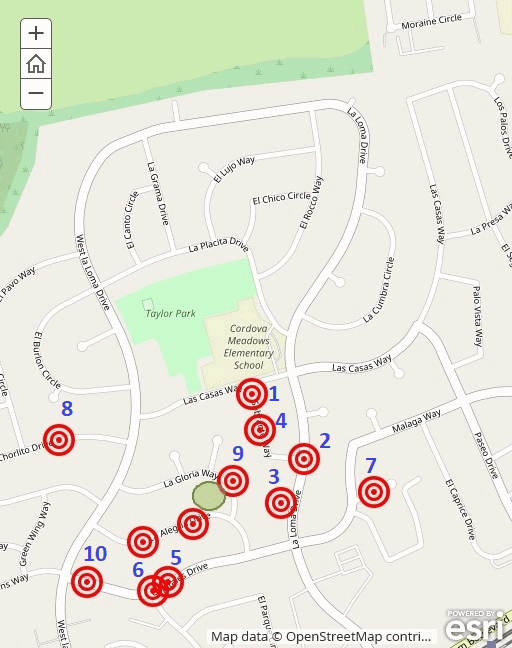
The numbers given to the prowl locations (supplied by me) indicate the sequence over which they were reported. Some, like No 7 and No 9, indicate hang-up phone calls but not prowling, though obviously the prowling had occurred already and the homeowners had been unaware of it. Some like 1, 2, and 4, indicate both prowling activity reported by the homeowner and hang-up phone calls. Put together the sequence indicates that EAR-ONS came to the community from the north, which means he came down La Loma Drive or Las Casas Way and began his prowling on El Sobrante (1, 4), then following it to where it connects with La Loma (2), then across the street to Toro Court (3), then back up to El Sobrante (No 1, 4, again), then perhaps across the fences to La Gloria (which did not report hang-up calls for sometime yet) and then down La Alegria to Capitales (5,6) and then the other way to La Verta Court (7), and eventually even El Chorlito, which also is near where Las Casas ends at West La Loma Drive.
All of the numbers on the map and prowl locations indicate single, young women lived there alone or together or these were the residences of young married couples. The hang-up calls were coming regularly at 8 p.m. No 7 (La Verta Court) had been receiving them for a week prior to the murders on February 2, 1978. On that night she did not. Instead No 9 on La Gloria received the call.
On this same night, No 10 experienced an attempted break-in between 8 p.m. and 8:45 p.m. (She had been experiencing longstanding prowler activity.) Then by about 9 p.m. the Maggiores had their encounter with their killer outside or across the street from No 9 on La Gloria. EAR had attempted to break in to the house on Capitales just before this. Afterward he must have prowled up to his next location on La Gloria to peep at the house he had last called less than an hour ago.
Add to this sequence the details of the following map.
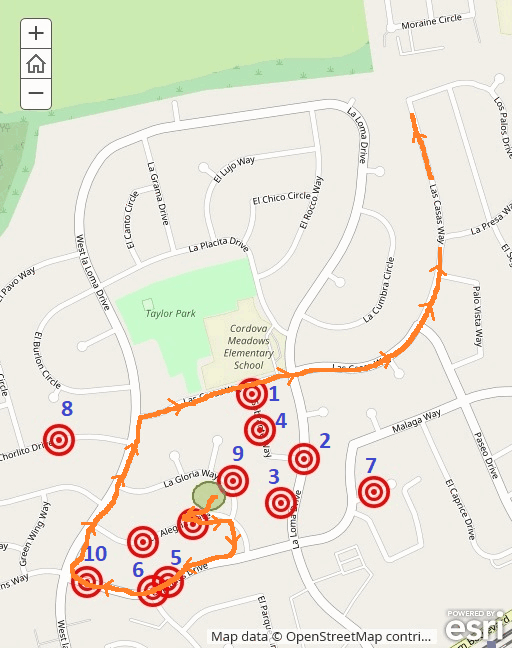
The orange line with accompanying arrows marks the direction of the Maggiore murderer’s retreat. It is a strange retreat on foot. Coupled with the fact that EAR made his last phone call that night at 8 p.m. and was already in the neighborhood to prowl Capitales and attempt break-in along the 2500 block (10) soon thereafter, it is obvious he was based close by. Both the hang-up calls and his retreat on foot reinforces he came by foot.
Since EAR had been prowling the area since the Summer of 1977, the above facts and now the sequence of prowl clusters tell us his lair was of longstanding and north of Cordova Meadows. Most likely he had accessed the area by having walked down La Loma Drive. Again, he had started on El Sobrante (the first street if coming from either La Loma Drive or Las Casas Way) and then worked his way further down La Loma. On the night of the attack, he started at No 10, indicating he had walked down West La Loma to Capitales.
Although the way he walked to the location is subjective, his retreat is not. He retreated on foot to a dead end area of Rancho Cordova.
Now let’s add the map below.
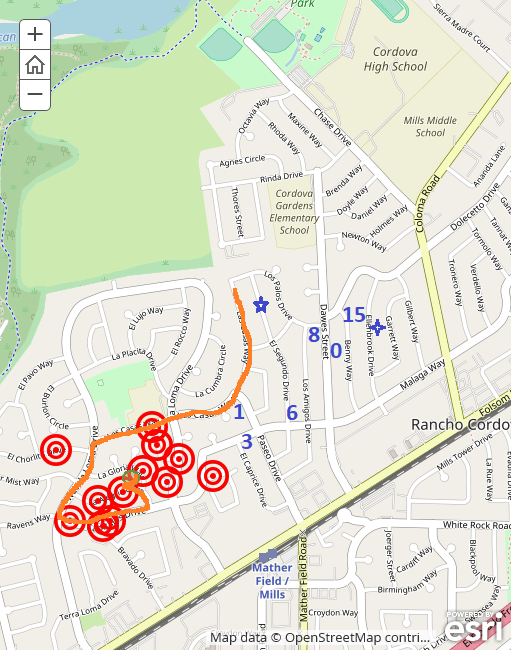
The prowl clusters in relation to the perpetrator’s retreat on the night of February 2, 1978, in context to the earlier victims of the East Area Rapist (marked by numbers). The star marks where EAR ditched Victim 8’s car. The 4-pointed star marks where he had parked behind Victim 15. But there is no evidence that he used a car at Victim 1, 3, 6. In fact, at Victim 3 he walked away naked from the waist down. He had arrived there smelling strongly of fresh after shave.
Altogether the circumstances indicate that EAR had a longstanding abode he could use in the area of Los Palos Drive. Yet it is unlikely he would have retreated straight to this location after the unplanned Maggiore murders. So it seems likely that to some extent the retreat was a ruse. It leads to a dead end deeper into Rancho C rather than to any direct escape route out of the town. The only way to another part of town up here is to jump fences and be back over on La Loma Drive or go through backyards on Los Palos. Most of these homes have gates onto a wooded canal behind them, and from here EAR could head in three different directions and be safe in another part of Rancho Cordova. Not surprisingly, just short of Los Palos Drive he is seen by witnesses for the last time. He then disappears. In like manner he had parked Victim 8’s car mid block on El Segundo between Los Palos and La Presa and vanished on October 18, 1976.
In both instances it seems safe to deduce that he had jumped fences and either crossed the canal behind Los Palos or the fences dividing Las Casas Way and La Loma Drive. In the case of the homes 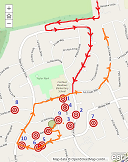 backing the canal behind Los Palos, most had gates onto the greenbelt, making it unnecessary to jump a fence. backing the canal behind Los Palos, most had gates onto the greenbelt, making it unnecessary to jump a fence.
A lair on or accessible by Moraine Circle or at the apex of La Loma Drive would explain many of the sequence of events between June 1976 and the events the night the Maggiores died. EAR would have made his final call from this location and then come down La Loma Drive just as he had done many times while prowling in the months before. But after the unexpected murder, he retreats back up to Los Palos, as he had done after his mistake with Victim 8. Here he can go through a yard, cross the canal on be on Moraine Circle, and from there he is in an entirely different part of town. The canal itself is a back door to 3 different communities. He has effectively covered his trail.
We now know that the alleged perpetrator DeAngelo grew up in this part of Rancho Cordova and even attended Mills Middle School nearby. The park, the canal, the field and levee and American River bank were all his potential playground, as they are today for Rancho Cordova kids. Please follow the picture sequence below before continuing.
Videos show the canal between Los Palos and Moraine Circle in March 2013 and the field and “training ground” as seen in August 2014, filmed by the author.
|
|
During more than one attack, EAR was said to smell strongly of after shave, as if it was recently applied. On one occasion I was told it smelled of cherry. Since I was in information overload at the time, I did not ask exactly where these locations were. But these instances could indicate EAR was within walking distance to his victim and was therefore using one of his “local lairs.” Plotting these attacks where he smelled of fresh after shave in connection to the alleged perpetrator’s past may reveal residences of old friends or family.
In like manner as above, the East Area Rapist stalked La Riviera largely on foot or by bike along the levee. This was vividly revealed in the case of No 11 (January 1977), where he also stole her car afterwards and then drove it quite a distance (the longest ever) and parked it on Great Falls Way near the apartments there. This suggests that he accessed La Riviera from the south and by foot (at least for this night). The map below illustrates what he did.
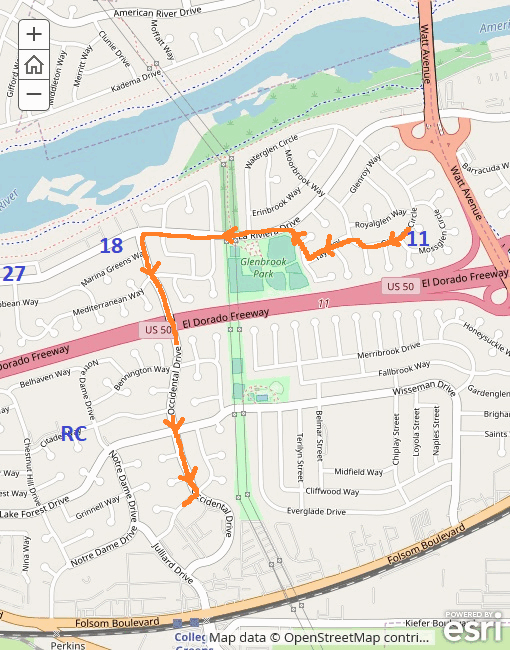
The reader can appreciate that EAR must have approached the residence on the 100 block of Glenville Circle from foot from quite a distance. He parked the victim’s car by a large apartment complex on Great Falls Way and Occidental Drive. Yet is seems unlikely he began his trek on foot from this far away. He probably doubled backed along Occidental Drive to a local lair much closer to La Riviera.
In February 1977 at Ripon Court (marked as RC) the prowler wanted to make sure he was not pursued. He shot young Rod Miller, in hot pursuit of him, and then fled. This prowler is heavily suspected to have been EAR. Interestingly enough, for the purposes here, no car was heard to start nearby afterward. Coupled with EAR’s actions recently after No 11, it could indicate his local lair was in this area.
The same must be reiterated for Little Pocket, where he struck Victim 32. Numerous hang-up phone calls preceded the attack on this 15 year old victim. A suspect was later seen jogging away on the Sacramento River levee. Like the suspect after the Maggiore Double Murder, this unconvincing jogger said something pointless and irrelevant to the witness when seen by her. He had a mustache. Curiously, around this time DeAngelo had a mustache.
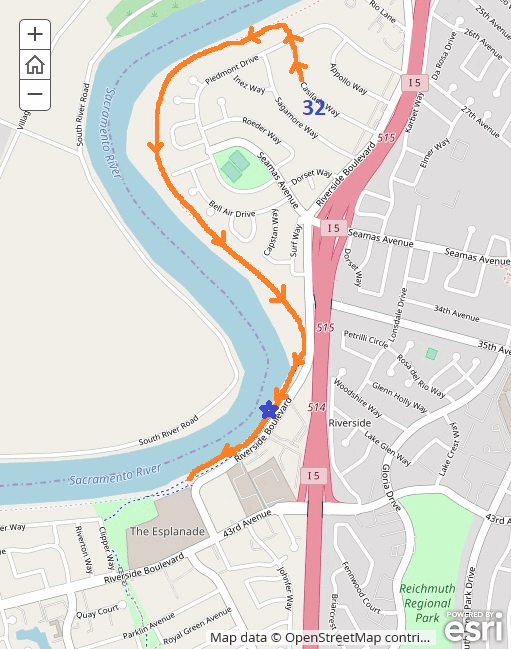
The most likely retreat of EAR from the victim location (32) to where the witness saw the jogger (star) at Minnow Hole. Although the victim was attacked on Casilada Way (at a baby sitting gig), she lived on the levee on Piedmont Drive. Riverside Blvd ends at large apartment complexes, and a pedestrian overpass takes one to more developments across Riverside Blvd/43rd Ave.
In each case, the hang-up phone calls were coming too soon before the attacks to indicate any perp calling from the Sierra foothills in Auburn. QED for any perp based in Auburn he had some lair in the attack areas. It is easiest to track in Rancho Cordova because of the trail EAR left after Victim 3, 8, and then after the Maggiores. For 32, it must be near the Greenhaven area in Sacramento. For La Riviera somewhere in College Glen or Rosemont.
These lairs, especially the one in Rancho Cordova, must have been heavily used by EAR if he could drive there each night and make his hang-up phone calls and then prowl the area so frequently afterward. (See Moments in Crime). And considering that his actions in Rancho Cordova over 1.5 years indicate he walked to these attacks (including No 6) this was a longstanding springboard.
Adding the alleged perp to the equation and we should stand amazed. He was in Auburn, a long distance away, but had grown up in Rancho Cordova. Following this same pattern in La Riviera and Greenhaven underscores for us how much driving was involved, how much scoping of local lairs was necessary (perhaps just empty homes), and together we see the considerable devotion he made to his prowling and assault of a potential victim.
Many of EAR’s attacks were preceded by unidentified cars cruising or seen parked night after night in the neighborhood where the attack was soon to take place. it is interesting to note that these three areas above are not noted for those pre-strike reports. The use of cars would indicate no nearby lair.
However, the purpose here is not to reveal lairs but to reveal through the details of the Maggiore Double Murders how the East Area Rapist walked amongst us. We have been given a lot of insight from the addition of Joe DeAngelo, the accused perpetrator, to the equation.
1, The actions of the mysterious cat burglar Cordova Cat over the period he was active 1972 to  Spring 1973 follow the same pattern that the East Area Rapist would use beginning in 1976. At this time DeAngelo was based in Citrus Heights. After the string of cat burglaries in the Birdcage area of Citrus Heights, the Cordova Cat walked a long distance to the apartments around Fairway Two Lane, where he dumped the rifled purses and wallets, indicating that he most likely had not driven to the burglary locations. Spring 1973 follow the same pattern that the East Area Rapist would use beginning in 1976. At this time DeAngelo was based in Citrus Heights. After the string of cat burglaries in the Birdcage area of Citrus Heights, the Cordova Cat walked a long distance to the apartments around Fairway Two Lane, where he dumped the rifled purses and wallets, indicating that he most likely had not driven to the burglary locations.
2, In May 1973, DeAngelo became an Exeter, CA, police officer. By 1974 the strange Visalia Ransacker is active in nearby Visalia. DeAngelo had taken his police training at College of the Sequoias in Visalia. The Ransacker based himself around the college, striking 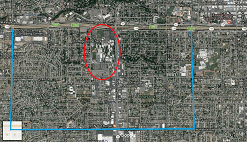 residences only within the neighborhoods east, west and south of it (a highway is to the north). The Ransacker attempted the kidnapping of Beth Snelling and is interrupted by her father, Claude Snelling. He shoots Claude Snelling down immediately. residences only within the neighborhoods east, west and south of it (a highway is to the north). The Ransacker attempted the kidnapping of Beth Snelling and is interrupted by her father, Claude Snelling. He shoots Claude Snelling down immediately.
3, DeAngelo becomes an Auburn police officer around early 1976. Here, he also had had family a few years before. He moves here to Granite Lane. During this period, beginning in June 1976 to late 1978, Rancho Cordova and the East Area are vexed by a tactical and shrewd home invasion rapist and sexual terrorist who becomes known as the East Area Rapist. He begins in Rancho Cordova and strikes back and forth between Rancho and Carmichael/Citrus Heights just like the earlier cat burglar the Cordova Cat. One shooting occurs south of La Riviera on Ripon Court. The victim is Rod Miller, who chased a prowler from their backyard. When getting close, the prowler shot him in the stomach. During a spate of typical EAR prowling signs the Maggiores are gunned down in Cordova Meadows. Cities further away— Stockton, Modesto, and Davis are also hit. Toward the later part of his Sacramento attacks, basically after the Maggiore murder suspect sketch is released, both EAR and DeAngelo seem to sport mustaches. DeAngelo had grown up in Rancho and had lived in Citrus Heights before.
4, In July 1979, DeAngelo is fired from Auburn Police for getting caught shoplifting dog repellent and a hammer from a Citrus Heights store. His “anger management issues”— in other words, temper— are well attested to here. He threatened to kill the chief of police and later at night the chief’s daughter reports a man with a flashlight shining it on her. The chief investigates and finds footprints outside. He suspects it was DeAngelo. This adds weight to the events following the Haskell Avenue Incident where EAR seems to specifically target a couple for revenge. (The Next Couple Dies!)
5, During the crime spree of the EAR, he seems to kill impulsively only in defense of his identity. This motive is seen in the shooting of Rod Miller, the Maggiores, and in the earlier killing by the Visalia Ransacker of professor Claude Snelling. Angered revenge is the motive for the threats after the Haskell Avenue incident. With DeAngelo, angered revenge is the assumed motive for his threat against his police chief and then possible attempt to bring this about at his home, if he is that night prowler. If it was DeAngelo at the chief’s house, it shows an arrogant and irrational temper. He would have been one of the first suspects had the chief been murdered.
6, After DeAngelo is fired, EAR is gone from northern Cal. He pops up in So. Cal and concentrates on two ends of the greater LA spectrum— Orange County and Santa Barbara County. No base of operations is known. But adding DeAngelo’s pattern, it would have to be where he had had previous contact. For Orange County, we know that in 1973 his mother and stepfather had lived in Garden Grove near Irvine.
In those places where DeAngelo did not have any link, EAR remained very close to the highways, like in Contra Costa county, though Concord is an exception. The same can be said for So. Cal.
The So. Cal attacks indicate a perp who was not based nearby in any permanent way, but would have had local lairs or had some familiarity with the area. As we can see from all of the above, this is one of EAR’s patterns.
Currently, DeAngelo’s work whereabouts at this time (1979-1989) are unknown, but real estate records show he bought his current house on April 11, 1980, nine months after being fired. He did not remain around Auburn, but came back to Citrus Heights where he had lived before moving to Exeter in 1973. Thus he remained based around Sacramento, perhaps because his wife was going to law school. The Smiths were murdered on March 13, 1980, a month before the house in Citrus Heights was purchased. So it is safe to deduce, if DeAngelo is the perpetrator of the Smiths’ murders, that he was doing heavy duty driving or had local springboards down south where he could stay for while working.
The Cordova Cat, Visalia Ransacker, The East Area Rapist, all now seem to be the same perpetrator. Each existed where DeAngelo had worked, lived or was schooled. Most likely, Night Stalker locations will follow this pattern as well. The pattern allows investigators to look into his past to uncover the connections.
|